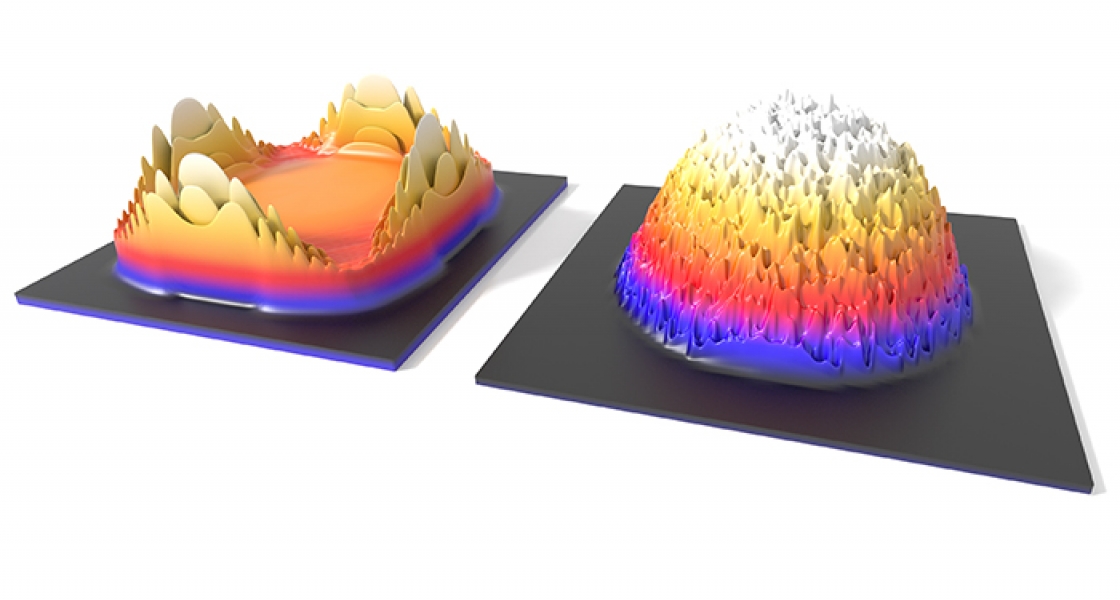When experimental physicists at Penn State were unable to observe some of the predicted behaviors of ultracold rubidium (Rb) atoms expanding inside a two-dimensional crystal of light, they turned to their theorist colleagues at the City University of New York and JILA for an explanation. Graduate student Shuming Li and Fellow Ana Maria Rey were happy to oblige.
A theoretical model of the experiment indicated that the atoms, when allowed to expand, would be clustered inside a slowly moving square-shaped fort-like barrier (the shape of the cloud predicted by the mean-field model) that prevented the atoms inside from moving any faster than the fort itself. The mean-field model assumes that one atom interacts with the average behavior of all the other atoms inside the cloud inside the fort. This simplified model predicted the behavior observed when the energy wells forming inside the crystal of light were shallow. However, when the experimenters adjusted the intensity of the laser that creates the crystal to make the energy wells deeper, the model could not reproduce the much slower atom expansion that occurred in response.
Rey and her collaborators figured out that as the wells grew deeper, it became harder for the strongly interacting atoms to move back and forth between adjacent wells. Eventually, the atoms could only move vertically — even though the deeper wells themselves were not impeding their movement. Curiously (because this is the quantum world), under these “frozen” conditions, the atoms became correlated or entangled. They actually seem to “know” what the other atoms around them were doing, even though none of the atoms had a cell phone.
What’s interesting about correlated atoms is that they lose their individual identities and become something altogether different from single atoms: they become a superposition of all possible characteristics of their component atoms. And the correlations themselves somehow give rise to a new type of self-trapping.
Correlated states usually appear when interactions are strong. Very strong interactions prevent the atoms from passing over or through other particles, especially if the atoms are confined in the same energy well. On occasion, some correlated Rb atoms can even stop acting like neighborly bosons (which can occupy the same quantum state) and start acting like fermions, which do everything they can to avoid getting close to each other.
These quantum correlations within energy wells can also suppress motion between adjacent quantum wells, according to Rey. Consequently, as soon as most of the atoms in the experiment became correlated and stopped moving, the entire cloud of Rb atoms seemed to become frozen in place, or trapped. In other words, because of the correlations in the quantum world inside the experiment, the Rb atoms in the lattice were actually trapping themselves!
The mean-field model does not capture quantum correlations and consequently predicts a much faster expansion rate than was observed when the energy wells were deeper. The mean-field theory’s assumption that there exists some kind of “average” atomic behavior breaks down under circumstances that favor entanglement.
Clearly, a new theory is required to explain the quantum behavior of strongly interacting ultracold atoms. This theory must take account of quantum correlations and interactions. It must also map out the details of how the behavior of ultracold atoms in a lattice leads to self-trapping.
Theorists Li and Rey have their work cut out for them. — Julie Phillips



 The Physics Frontiers Centers (PFC) program supports university-based centers and institutes where the collective efforts of a larger group of individuals can enable transformational advances in the most promising research areas. The program is designed to foster major breakthroughs at the intellectual frontiers of physics by providing needed resources such as combinations of talents, skills, disciplines, and/or specialized infrastructure, not usually available to individual investigators or small groups, in an environment in which the collective efforts of the larger group can be shown to be seminal to promoting significant progress in the science and the education of students. PFCs also include creative, substantive activities aimed at enhancing education, broadening participation of traditionally underrepresented groups, and outreach to the scientific community and general public.
The Physics Frontiers Centers (PFC) program supports university-based centers and institutes where the collective efforts of a larger group of individuals can enable transformational advances in the most promising research areas. The program is designed to foster major breakthroughs at the intellectual frontiers of physics by providing needed resources such as combinations of talents, skills, disciplines, and/or specialized infrastructure, not usually available to individual investigators or small groups, in an environment in which the collective efforts of the larger group can be shown to be seminal to promoting significant progress in the science and the education of students. PFCs also include creative, substantive activities aimed at enhancing education, broadening participation of traditionally underrepresented groups, and outreach to the scientific community and general public.